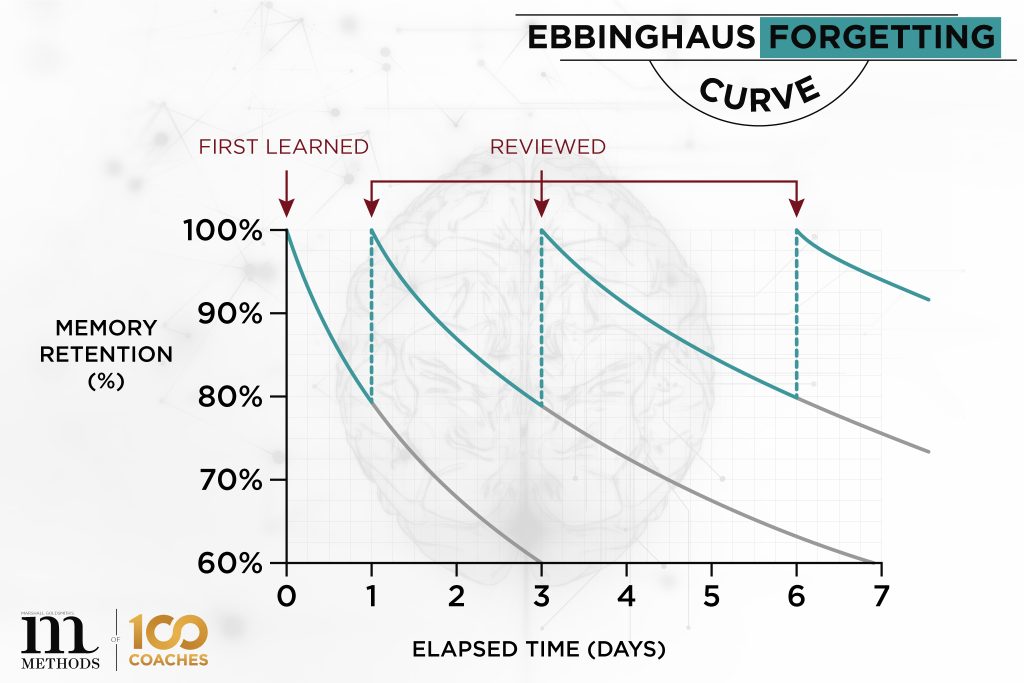Forgetting things you learned during your initial training is common and can be frustrating, especially when trying to understand a new digital skill or process. This can also build stress and make the learner less confident and productive.
The phenomenon of forgetting crucial information after training sessions is a significant challenge in software training, onboarding, and change management. This undermines the investment in employee development and hampers productivity and confidence among learners.
The concept of the Forgetting Curve, introduced by Hermann Ebbinghaus in the late 19th century, offers insight into the mechanics of memory and highlights the decline in our ability to recall information over time. This curve shows that nearly 90% of new knowledge can be lost without deliberate review within a month.
Investing time and money in course creation and employee training becomes futile when your employees are unlikely to retain the information. For L&D professionals, this represents a clear challenge.
The Forgetting Curve is one of the biggest burdens in the learning and development or software training community. This blog will help you understand the Forgetting Curve, how it impacts employee training, and how you can overcome it.

What is the Forgetting Curve?
The Forgetting Curve demonstrates the rate at which people forget newly learned information when they fail to continuously review the material.
In an employee training context, the Forgetting Curve indicates that employees can forget almost 90% of the information they learn within the first month. That means they’ve virtually forgotten everything after onboarding is complete (averaging 1-3 months).
Enterprises invest a lot of time and money in employee training, but if employees cannot remember what they learned, these efforts return little to no value. Keep reading to learn how the Forgetting curve can impact employee training.
Forgetting Curve’s impact on employee training
The Forgetting Curve’s implications for employee training are profound. Traditional training methods, which often rely on one-time information delivery, are rendered ineffective as employees quickly forget vital skills and knowledge. This leads to decreased productivity and increased reliance on IT support and colleagues, further diluting efficiency.
Training managers and L&D professionals know how often employees forget what they learn during a training program, especially when they’re tasked with learning multiple processes, software applications, and department structures within days.
The human brain usually can’t remember every piece of information it has consumed.

Ebbinghaus conducted experiments on himself in the late 19th century to understand memory and forgetting. His findings, published in 1885 in his book “Memory: A Contribution to Experimental Psychology,” demonstrate that memory retention declines over time in a predictable pattern unless the information is consciously reviewed. Ebbinghaus found that significant information loss happens within the first hours and days after learning, suggesting that the brain does not retain every piece of information it encounters.
Moreover, cognitive load theory, developed by John Sweller in the late 20th century, provides additional insight into why the brain can’t remember every piece of information it consumes. This theory posits that working memory has limited capacity and can only hold a few chunks of information at any given time (Miller, 1956). Information exceeding this capacity can lead to cognitive overload, hindering learning and memory retention.
Further research into the spacing effect, which refers to the phenomenon where learning is more effective when study sessions are spaced out over time, supports the idea that retention improves with repeated exposure to information across intervals (Cepeda et al., 2006). This suggests that the brain will likely forget information over time without these repeated exposures.
Ebbinghaus’ Forgetting Curve proves that most traditional employee training methods are ineffective. Employees might forget everything they learn after a few weeks of training unless they make an effort to revisit the training materials frequently–if they can find all the training materials needed while trying to complete a time-sensitive process.
General practice for modern enterprises focuses on speeding up onboarding cycle times without effective reiteration, programs, or frequent plans for post-implementation. If employees forget how to perform a task, three things can happen:
- Employees might ask a co-worker for help or ask them to share related training material
- Employees might start bothering your IT team for additional assistance
- Employees might not ask anyone, resulting in a loss of data integrity and higher compliance risks


Whatever the case, the result is a loss of employee productivity and training dilution, creating compliance and process issues.
Several employees forget what they have learned a few weeks after training them on Salesforce, CA PPM, Workday, or any other application, leading to productivity loss.
We have already visited the impact of the forgetting curve on Salesforce training and the ways you can overcome it in another blog. You can read more here: Salesforce Training & The Impact of the Forgetting Curve.
Now, the big question: How do we beat the Forgetting Curve?
Enterprises can focus on Digital Adoption and start leveraging Digital Adoption Platforms to overcome the Forgetting Curve and ensure employee productivity.
Combatting the Forgetting Curve necessitates a strategic approach to learning that includes continuous reinforcement and the application of digital adoption platforms (DAPs). DAPs offer a dynamic solution to the challenge of memory retention by embedding learning directly into the workflow. Here are three methods to leverage DAPs effectively:
3 Ways to Combat the Forgetting Curve with DAP
- Task Guidance
- Engagement & Interactivity
- 24/7 Access to Support
First, Guide Employees Through Tasks & Software Processes
If tools like a digital adoption platform (DAP) are implemented, your employees will no longer need to memorize processes to perform a task. The root cause of the Forgetting Curve is contextual guidance in the time of need: repetition.
DAPs help employees learn processes faster by performing the tasks themselves without asking for outside help: self-help interactive guidance. DAPs shows employees how to perform a task in real-time with in-app guidance.
Apty, a digital adoption platform, provides real-time, in-app guidance, allowing employees to learn by doing. This method significantly counters the Forgetting Curve by associating learning directly with task performance, embedding knowledge more deeply into the user’s memory. Interactive software walkthroughs enhance engagement and ensure employees can perform tasks accurately without extensive traditional training and support costs.

A DAP can make training effective without hours of sessions or assistance from training managers. The interactive software walkthroughs of a DAP can create an engaging product experience for end-users.
A DAP like Apty guides employees to complete tasks accurately, ensuring increased employee productivity and seamless product adoption.
Second, Keep Software Learning Engaging
According to Gallup’s State of the American Workplace report, 70% of the U.S workforce is disengaged at work. Without employee engagement, there is no point in providing training. A DAP can make your employee learning experience engaging and exciting.

The User Experience (UX) and User Interface (UI) provided by the software that you use will be revamped with a DAP installed. This will also provide a consistent interface for employees across different software. Employees can easily overcome the Forgetting Curve with the help of Apty DAP’s personalized interactive software walkthroughs.
Apty DAP’s On-screen guidance, in-app announcements, and tooltips can create a better employee experience that keeps them engaged throughout the training.
Most importantly, Apty’s advanced analytics help leaders get deeper insights into employees’ behavior with your enterprise applications. This insight can be used to fix gaps and make processes much more seamless.
Three, Offer 24/7 Software Self-help Support
A Digital Adoption Platform integrates L&D content in the form PDFs, videos, and permalinks, creating holistic and interactive guidance tailored to how the end user’s need and style of learning. It can make your training material accessible to learners at any time and place. Making it accessible 24/7 can minimize the effect of the Forgetting Curve.


When an employee faces a challenge while performing a task, they should know where to find a solution.
With Apty DAP, employees get 24/7 guidance. It identifies the employee’s exact pain points and provides real-time support with the help of customized in-app walkthroughs. Apty walkthroughs keep your employees engaged at work and improve their performance.
How Does Understanding The Forgetting Curve Help Employee Learning & Development
Understanding the Forgetting Curve’s impact on software training, onboarding, and change management is crucial for any organization aiming to enhance its learning and development (L&D) efforts. This curve poses a significant challenge in employee training, where research suggests that up to 90% of new information can be forgotten within the first month if not properly reinforced.
Building Strategies for Effective Learning
Reinforced Learning with a Digital Adoption Platform
- Continuous Learning and Reinforcement: The crux of overcoming the Forgetting Curve lies in continuous learning. Regularly revisiting and reinforcing training materials helps to solidify knowledge. Implementing spaced repetition, where review sessions are strategically scheduled over increasing intervals, has been proven to improve long-term memory retention.
A. Digital adoption platforms like Apty reinforce training without disrupting the employees’ experience while using applications. Instead, DAPs support employees in their time of need through engaging walkthroughs and integrated L&D training materials that may have otherwise gone unutilized.
B. Leadership can increase productivity and efficiency by creating a supportive software environment with DAPs. With validated and compliant software processes they can also rely on software outputs for data-informed decision making.
C. With proper software adoption and simplified software change management protocols, CIOs and CTOs will see less SaaS sprawl and scope creep. Due to DAPs and a software adoption plan in place, they’ll see fewer application customization projects attempting to control forgetfulness or correct faulty data from misused software processes.
Software Adoption Strategy with a Digital Adoption Platform
- Utilizing Digital Adoption Platforms (DAPs): DAPs like Apty offer an innovative solution to the Forgetting Curve. They provide real-time, in-application guidance and support, allowing employees to learn by doing, enhancing knowledge retention and application.
- A. Guided Learning: By guiding users through tasks within the actual software environment, DAPs ensure that learning is relevant and immediately applicable. This hands-on approach combats the Forgetting Curve and increases confidence and proficiency in using new software tools.
- B. Engagement and Interactive Learning: Engaging learning experiences are key to retention. DAPs can transform mundane training into interactive, engaging experiences through on-screen guidance, personalized walkthroughs, and contextual help. This not only makes learning more enjoyable but also more memorable.
- c. On-Demand Support: Providing 24/7 access to support resources and training materials ensures that help is available whenever and wherever it’s needed. This constant accessibility helps employees overcome obstacles quickly and reinforces learning outside of formal training sessions.
Data-Backed Insights and Metrics
Studies and data underscore the importance of addressing the Forgetting Curve in training programs. For instance, the Ebbinghaus Forgetting Curve indicates a significant drop in knowledge retention in just a matter of days without reinforcement. Furthermore, Gallup’s “State of the American Workplace” report highlights that 70% of U.S. workers are not engaged at work, underscoring the need for more engaging training solutions.

Moreover, implementing DAPs has shown promising results in enhancing learning outcomes. For example, organizations with integrated DAPs report significant improvements in software proficiency, reduced support tickets, and higher employee engagement levels.

Implementing Effective Training with Digital Adoption Platforms
To effectively combat the Forgetting Curve and enhance software training and adoption, organizations should:
- Incorporate continuous learning and reinforcement into their training programs.
- Leverage the capabilities of Digital Adoption Platforms to provide real-time, contextual guidance and support.
- Focus on creating engaging, interactive learning experiences encouraging active participation and long-term retention.
- Utilize the analytics and insights provided by DAPs to identify learning gaps and tailor training to meet employees’ specific needs.
As outlined above, overcoming the Forgetting Curve requires a strategic approach to learning and development, emphasizing continuous reinforcement, engaging training methodologies, and the innovative use of technology. By implementing these strategies and leveraging tools like Digital Adoption Platforms, organizations can significantly improve the effectiveness of their training programs, ensuring that employees not only acquire but retain the knowledge and skills necessary for success.
Simplifying Training, Onboarding, & Career Advancement with a DAP
There is a simple solution to help employees overcome the forgetting curve: continued learning. Employees cannot be expected to learn everything in the initial training and retain continuously evolving information forever. They need to be given opportunities to revisit what they have learned or go beyond what they’ve learned. The easier it is to access this information, the faster they learn, adapt, and improve.
This is where Apty DAP helps. It simplifies your training efforts by providing 24/7 real-time guidance and easily accessible and understandable training content to employees.
Simplifying training and onboarding processes is paramount for enhancing learning outcomes and ensuring efficient knowledge transfer in today’s fast-paced digital work environment. By leveraging the insights from cognitive psychology and employing innovative solutions like Digital Adoption Platforms (DAPs), organizations can significantly reduce the cognitive load on employees, making learning more engaging and effective. These strategies not only help in combating the natural tendency of the forgetting curve but also facilitate a smoother transition for new hires, ultimately leading to increased productivity and job satisfaction. Embracing these approaches means investing in your workforce’s development and setting up your organization for greater success in the digital age.
Empowering Career & Company Growth Through Effective Training
Furthermore, streamlining training and onboarding directly ties into employee career advancement, maximizing software ROI for the company and propelling overall company advancement. When employees are provided with resources that cater to effective learning and continuous development, they are better positioned to take on more complex roles and responsibilities, thereby advancing their careers. This empowerment boosts employee morale and contributes to a more skilled and versatile workforce.
From a company’s perspective, effective training ensures that the investments made in software and technology yield the highest possible returns. Employees proficient in utilizing these tools can optimize operations, innovate processes, and drive efficiencies, leading to significant cost savings and enhanced productivity. Ultimately, these advancements contribute to the company’s competitive edge in the market, fostering growth and sustainability. By prioritizing simplified training and onboarding, organizations enhance individual employee performance and lay a strong foundation for their long-term success and industry leadership.












